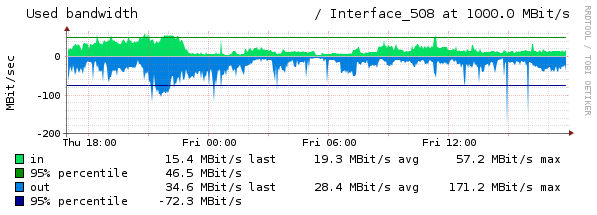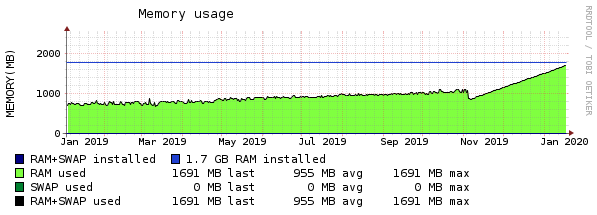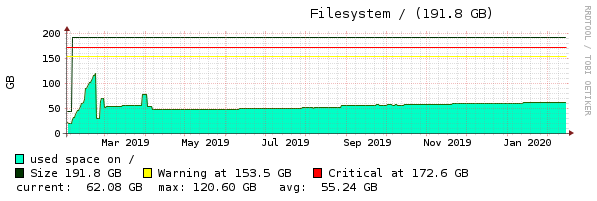|
|
Sponsored Content
Top Forums
UNIX for Advanced & Expert Users
Nearly Random, Uncorrelated Server Load Average Spikes
Post 303044127 by stomp on Friday 14th of February 2020 12:23:07 PM
|
|
10 More Discussions You Might Find Interesting
1. UNIX for Advanced & Expert Users
we have an unix system which has
load average normally about 20.
but while i am running a particular unix batch which performs heavy
operations on filesystem and database average load
reduces to 15.
how can we explain this situation?
while running that batch idle cpu time is about %60-65... (0 Replies)
Discussion started by: gfhgfnhhn
0 Replies
2. UNIX for Dummies Questions & Answers
Hello all, I have a question about load averages.
I've read the man pages for the uptime and w command for two or three different flavors of Unix (Red Hat, Tru64, Solaris). All of them agree that in the output of the 2 aforementioned commands, you are given the load average for the box, but... (3 Replies)
Discussion started by: Heathe_Kyle
3 Replies
3. UNIX for Dummies Questions & Answers
Hello, Here is the output of top command. My understanding here is,
the load average 0.03 in last 1 min, 0.02 is in last 5 min, 0.00 is in last 15 min.
By seeing this load average, When can we say that, the system load averge is too high?
When can we say that, load average is medium/low??... (8 Replies)
Discussion started by: govindts
8 Replies
4. Solaris
Hi,
i have installed solaris 10 on t-5120 sparc enterprise.
I am little surprised to see load average of 2 or around on this OS.
when checked with ps command following process is using highest CPU. looks like it is running for long time and does not want to stop, but I do not know... (5 Replies)
Discussion started by: upengan78
5 Replies
5. UNIX for Dummies Questions & Answers
Hello AlL,..
I want from experts to help me as my load average is increased and i dont know where is the problem !!
this is my top result :
root@a4s # top
top - 11:30:38 up 40 min, 1 user, load average: 3.06, 2.49, 4.66
Mem: 8168788k total, 2889596k used, 5279192k free, 47792k... (3 Replies)
Discussion started by: black-code
3 Replies
6. UNIX for Advanced & Expert Users
Hi ,
I am using 48 CPU sunOS server at my work.
The application has facility to check the current load average before starting a new process to control the load.
Right now it is configured as 48. So it does mean that each CPU can take maximum one proces and no processe is waiting.
... (2 Replies)
Discussion started by: kumaran_5555
2 Replies
7. Solaris
NPROC USERNAME SWAP RSS MEMORY TIME CPU
320 oracle 23G 22G 69% 582:55:11 85%
47 root 148M 101M 0.3% 99:29:40 0.3%
53 rafmsdb 38M 60M 0.2% 0:46:17 0.1%
1 smmsp 1296K 5440K 0.0% 0:00:08 0.0%
7 daemon ... (2 Replies)
Discussion started by: snjksh
2 Replies
8. UNIX for Dummies Questions & Answers
Hi,
I am getting a high load average, around 7, once an hour. It last for about 4 minutes and makes things fairly unusable for this time.
How do I find out what is using this. Looking at top the only thing running at the time is md5sum.
I have looked at the crontab and there is nothing... (10 Replies)
Discussion started by: sm9ai
10 Replies
9. UNIX for Dummies Questions & Answers
how load average is calculated and what exactly is it
difference between cpu% and load average (9 Replies)
Discussion started by: robo
9 Replies
10. Programming
Here we go....
Preface:
..... so in a galaxy far, far, far away from commercial, data sharing corporations.....
For this project, I used the ESP-WROOM-32 as an MQTT (publish / subscribe) client which receives Linux server "load averages" as messages published as MQTT pub/sub messages.... (6 Replies)
Discussion started by: Neo
6 Replies
LEARN ABOUT DEBIAN
rrdcgi
RRDCGI(1) rrdtool RRDCGI(1) NAME
rrdcgi - Create web pages containing RRD graphs based on templates SYNOPSIS
"#!/path/to/"rrdcgi [--filter] DESCRIPTION
rrdcgi is a sort of very limited script interpreter. Its purpose is to run as a cgi-program and parse a web page template containing special <RRD:: tags. rrdcgi will interpret and act according to these tags. In the end it will printout a web page including the necessary CGI headers. rrdcgi parses the contents of the template in 3 steps. In each step it looks only for a subset of tags. This allows nesting of tags. The argument parser uses the same semantics as you are used from your C-shell. --filter Assume that rrdcgi is run as a filter and not as a cgi. Keywords RRD::CV name Inserts the CGI variable of the given name. RRD::CV::QUOTE name Inserts the CGI variable of the given name but quotes it, ready for use as an argument in another RRD:: tag. So even when there are spaces in the value of the CGI variable it will still be considered to be one argument. RRD::CV::PATH name Inserts the CGI variable of the given name, quotes it and makes sure it starts neither with a '/' nor contains '..'. This is to make sure that no problematic pathnames can be introduced through the CGI interface. RRD::GETENV variable Get the value of an environment variable. <RRD::GETENV REMOTE_USER> might give you the name of the remote user given you are using some sort of access control on the directory. RRD::GOODFOR seconds Specify the number of seconds this page should remain valid. This will prompt the rrdcgi to output a Last-Modified, an Expire and if the number of seconds is negative a Refresh header. RRD::INCLUDE filename Include the contents of the specified file into the page returned from the cgi. RRD::SETENV variable value If you want to present your graphs in another time zone than your own, you could use <RRD::SETENV TZ UTC> to make sure everything is presented in Universal Time. Note that the values permitted to TZ depend on your OS. RRD::SETVAR variable value Analog to SETENV but for local variables. RRD::GETVAR variable Analog to GETENV but for local variables. RRD::TIME::LAST rrd-file strftime-format This gets replaced by the last modification time of the selected RRD. The time is strftime-formatted with the string specified in the second argument. RRD::TIME::NOW strftime-format This gets replaced by the current time of day. The time is strftime-formatted with the string specified in the argument. Note that if you return : (colons) from your strftime format you may have to escape them using if the time is to be used as an argument to a GRAPH command. RRD::TIME::STRFTIME START|END start-spec end-spec strftime-format This gets replaced by a strftime-formatted time using the format strftime-format on either start-spec or end-spec depending on whether START or END is specified. Both start-spec and end-spec must be supplied as either could be relative to the other. This is intended to allow pretty titles on graphs with times that are easier for non RRDtool folks to figure out than "-2weeks". Note that again, if you return : (colon) from your strftime format, you may have to escape them using if the time is to be used as an argument to a GRAPH command. RRD::GRAPH rrdgraph arguments This tag creates the RRD graph defined by its argument and then is replaced by an appropriate <IMG ... > tag referring to the graph. The --lazy option in RRD graph can be used to make sure that graphs are only regenerated when they are out of date. The arguments to the RRD::GRAPH tag work as described in the rrdgraph manual page. Use the --lazy option in your RRD::GRAPH tags, to reduce the load on your server. This option makes sure that graphs are only regenerated when the old ones are out of date. If you do not specify your own --imginfo format, the following will be used: <IMG SRC="%s" WIDTH="%lu" HEIGHT="%lu"> Note that %s stands for the filename part of the graph generated, all directories given in the PNG file argument will get dropped. RRD::PRINT number If the preceding RRD::GRAPH tag contained and PRINT arguments, then you can access their output with this tag. The number argument refers to the number of the PRINT argument. This first PRINT has number 0. RRD::INTERNAL <var> This tag gets replaced by an internal var. Currently these vars are known: VERSION, COMPILETIME. These vars represent the compiled-in values. EXAMPLE 1 The example below creates a web pages with a single RRD graph. #!/usr/local/bin/rrdcgi <HTML> <HEAD><TITLE>RRDCGI Demo</TITLE></HEAD> <BODY> <H1>RRDCGI Example Page</H1> <P> <RRD::GRAPH demo.png --lazy --title="Temperatures" DEF:cel=demo.rrd:exhaust:AVERAGE LINE2:cel#00a000:"D. Celsius"> </P> </BODY> </HTML> EXAMPLE 2 This script is slightly more elaborate, it allows you to run it from a form which sets RRD_NAME. RRD_NAME is then used to select which RRD you want to use as source for your graph. #!/usr/local/bin/rrdcgi <HTML> <HEAD><TITLE>RRDCGI Demo</TITLE></HEAD> <BODY> <H1>RRDCGI Example Page for <RRD::CV RRD_NAME></H1> <H2>Selection</H2> <FORM><INPUT NAME=RRD_NAME TYPE=RADIO VALUE=roomA> Room A, <INPUT NAME=RRD_NAME TYPE=RADIO VALUE=roomB> Room B. <INPUT TYPE=SUBMIT></FORM> <H2>Graph</H2> <P> <RRD::GRAPH <RRD::CV::PATH RRD_NAME>.png --lazy --title "Temperatures for "<RRD::CV::QUOTE RRD_NAME> DEF:cel=<RRD::CV::PATH RRD_NAME>.rrd:exhaust:AVERAGE LINE2:cel#00a000:"D. Celsius"> </P> </BODY> </HTML> EXAMPLE 3 This example shows how to handle the case where the RRD, graphs and cgi-bins are separate directories #!/.../bin/rrdcgi <HTML> <HEAD><TITLE>RRDCGI Demo</TITLE></HEAD> <BODY> <H1>RRDCGI test Page</H1> <RRD::GRAPH /.../web/pngs/testhvt.png --imginfo '<IMG SRC=/.../pngs/%s WIDTH=%lu HEIGHT=%lu >' --lazy --start -1d --end now DEF:http_src=/.../rrds/test.rrd:http_src:AVERAGE AREA:http_src#00ff00:http_src > </BODY> </HTML> Note 1: Replace /.../ with the relevant directories Note 2: The SRC=/.../pngs should be paths from the view of the webserver/browser AUTHOR
Tobias Oetiker <tobi@oetiker.ch> 1.4.7 2008-12-22 RRDCGI(1)



